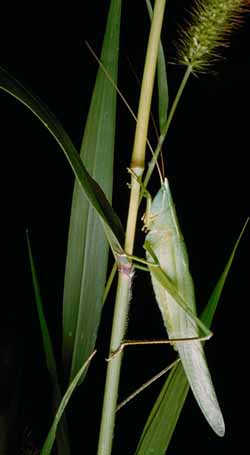
University of Florida
(Neoconocephalus ensiger)
Interesting facts:
The ears of the conehead grasshopper (and many other long-horned grasshoppers or katydids) are located at the top of the tibia (lower section) of each front leg. They can hear the sounds of some of their predators, such as the sounds put out by bats when they are trying to locate prey.
Description:
The sword-bearing conehead is a large, long-horned grasshopper. At night, the male makes chirping sounds by rubbing its wings together.
Habitat and behavior:
Conehead grasshoppers can be found on grasslands, prairies, pastures, meadows, fencerows, and in vegetation along railroad tracks. Long-horned grasshoppers are insects with incomplete metamorphosis. The female lays eggs in autumn. The next spring, eggs hatch to nymphs, which look like miniature adults without wings. As they grow, they molt their exoskeletons several times. They grow wings in the last stage of development.
Food:
Nymphs and adults feed on leaves and other plant parts.
Predators:
Birds
Distribution and status:
Grassland and prairies of the United States and Canada.
Location in Illinois:
It has been found in the norther two-thirds of Illinois, more commonly on the eastern side of the state.